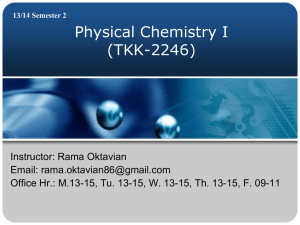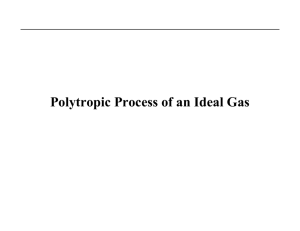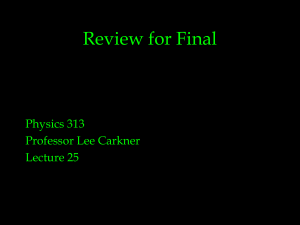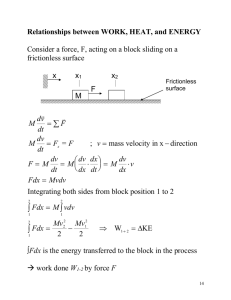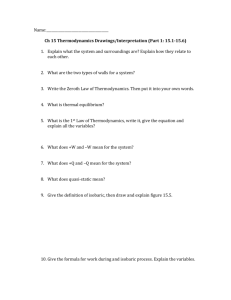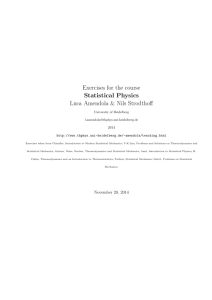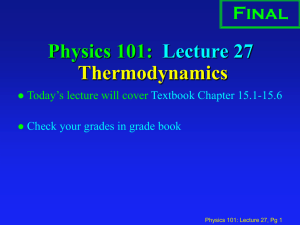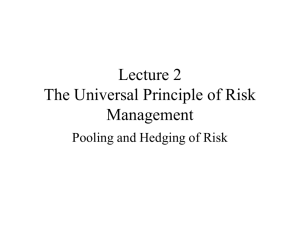Thermo II : ch. 19+20
advertisement
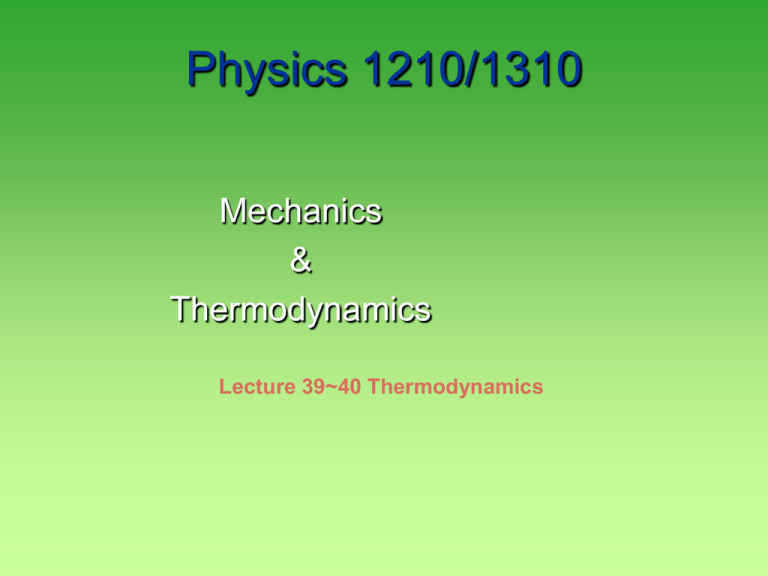
Physics 1210/1310 Mechanics & Thermodynamics Lecture 39~40 Thermodynamics Phase Diagrams For an ideal gas For a substance which expands on melting First and Second Law of Thermodynamics And Types of Thermodynamic Processes Thermodynamic systems Isolated systems can exchange neither energy nor matter with the environment. reservoir reservoir Heat Heat Work Work Closed systems exchange energy but not matter with the environment. Open systems can exchange both matter and energy with the environment. Quasi-static processes Quasi-static processes: near equilibrium States, initial state, final state, intermediate state: p, V & T well defined • Sufficiently slow processes = any intermediate state can be considered as at thermal equilibrium. • Criterion: It makes sense to define a temperature (ie) there is a statistical average • Examples of quasi-static processes: - iso-thermal: T = constant - iso-volumetric: V = constant - iso-baric: P = constant - adiabatic: Q=0 Work done equals area under curve in pV diagram Expansion: work on piston positive, work on gas negative Compression: work on piston negative, work on gas positive 1st Law: The change of the total energy of a thermodynamic system depends on change of heat in system and work done. More generally DE = DK + DUg +DU State functions a c b a. isovolumetric b. isobaric W Pf (V f Vi ) a. isobaric b. isovolumetric W Pi (V f Vi ) isothermal Vf W PdV Vi • the work done by a system depends on the initial and final states and on the path it is not a state function. • energy transfer by heat also depends on the initial, final, and intermediate states it is not a state function either. Kinds of Thermodynamic Processes: Adiabatic – no heat transfer (by insulation or by very fast process) U2 – U1 = -W Isochoric – constant volume process (no work done on surroundings) U2 – U1 = Q Isobaric – constant pressure process W = p (V2 – V1) Isothermal – constant temperature process (heat may flow but very slowly so that thermal equilibrium is not disturbed) DU, Q , W not zero: any energy entering as heat must leave as work Ideal gas – iso-volumetric process P 2V Nk BT2 P 2 Isovolumetric process: V = constant V2 W PdV 0 V1 1 P1V Nk BT 1 V1,2 reservoir Heat V Q CV (T2 T1 ) CV DT (CV: heat capacity at constant volume) DU Q W DU Q CV DT During an iso-volumetric process, heat enters (leaves) the system and increases (decreases) the internal energy. Ideal gas - isobaric process PV 2 Nk BT 2 P V2 W PdV P(V2 V1 ) PDV 2 1 Isobaric process: P = constant V1 PV 1 Nk BT1 V1 V2 V Q C p (T2 T1 ) C p DT (CP: heat capacity at constant pressure) DU Q W reservoir C P DT PDV Heat Work During an isobaric expansion process, heat enters the system. Part of the heat is used by the system to do work on the environment; the rest of the heat is used to increase the internal energy. Ideal gas - isothermal process P P1V 1 Nk BT 1 P 2V 2 Nk BT 2 Isothermal process: T = constant DU 0 V2 V2 V1 V1 W PdV V1 V2 V Expansion: heat enters the system all of the heat is used by the system to do work on the environment. Compression: energy enters the system by the work done on the system, all of the energy leaves the system at the same time as the heat is removed. NkBT dV V dV NkBT V1 V V2 NkBT ln V1 V2 V2 Q W Nk BT ln V1 Ideal gas - adiabatic process P 2V 2 Nk BT2 P P P(V, T) 2 1 V2 P1V 1 Nk BT 1 V1 Ideal gas: f U NkBT 2 f dU NkB dT 2 Adiabatic process: dU dQ dW PdV V Adiabatic process: Q = 0 V2 V2 V1 V1 W PdV P(V , T )dV PV NkBT d ( PV ) d ( NkBT ) PdV VdP NkB dT f NkB dT PdV 2 2 NkB dT PdV f f is degree of freedom PdV VdP 2 PdV f Ideal gas - adiabatic process (contd) P 2 P P(V , T ) PdV VdP VdP (1 1 V2 V1 let (1 V 2 PdV f 2 ) PdV 0 f 2 ) , and divided by PV f dP dV 0 P V V dV dP P1 P V1 V 0 P V ln ln 0 P1 V1 P PV ln 0 P1V1 PV P1V1 constant Ideal gas - adiabatic process (contd) P PV constant 2 PV P1V1 constant V2 W PdV P1V1 V1 1 V2 V1 V W P1V1 V2 V1 dV V 1 1 1 ( ) ( 1) V2 V1 constant For monatomic gas, f 3 2 1 1.7 3 For diatomic gas, = 1+2/5 = 1.4 f =5 at normal T (threshold not met) f=7 at very high T Ideal gas - adiabatic process (contd) P PV constant 2 P1V1 NkBT1 1 V2 V1 PV P1V1 constant V P2V2 NkBT2 P1V1 P2V2 V2 1 T1 1 V1 T2 or 1 T1 V1 P1 V1 T1 P2 V2 T2 P V 1 2 P2 V1 T2 V2 1 constant Ideal gas - adiabatic process (contd) P PV constant 2 PV P1V1 constant 1 T1 V1 1 V2 V1 T2 V2 1 constant PV NkBT V 1 1 1 W P1V1 ( ) ( 1) V2 V1 During an adiabatic expansion process, the reduction of the internal energy is used by the system to do work on the environment. During an adiabatic compression process, the environment does work on the system and increases the internal energy. Summary Quasi-static process Character isovolumetric V = constant isobaric P = constant isothermal T = constant adiabatic Q0 DU Q W DU Q Q CV DT W 0 DU Q W Q CP DT W PDV DU 0 Q W DU W Q0 W NkBT ln W P1V1 V2 V1 1 1 1 ( ) ( 1) V2 V1 Carnot Cycle The best-e cycle 2 reversible isothermal and 2 reversible adiabatic processes. 4 stroke or Otto engine intake stroke compression stroke ignition power stroke exhaust stroke Bottom right Ta, bottom left Tb Use T*V-1 = const. law for the two adiabatic processes For r=8, j = 1.4 e=56% Diesel Cycle Typical rexp ~ 15, rcomp ~ 5 Second Law of Thermodynamics No system can undergo a process where heat is absorbed and convert the heat into work with the system ending in the state where it began: No perpetuum mobile. b/c heat cannot flow from a colder to a hotter body w/o a cost (work). iow e=100% is not possible! Reversible vs irreversible processes. Second Law of Thermodynamics: gives direction to processes No system can undergo a process where heat is absorbed and convert the heat into work with the system ending in the state where it began: No perpetuum mobile. There are many other useful state functions: the thermodynamic potentials Enthalpy H = U + PV Free energy at const P, T G = U + PV - TS Free energy at const. T F = U – TS Entropy S etc. The first law revised (for a p-V-T system): DU= TdS - pdV Entropy: macroscopic interpretation: Cost of Order – reversible and irreversible processes Total entropy change zero: reversible Use dQ = T dS in first law! DU = TDS - pDV What is this entropy? No easy answer, dep. on the case Entropy: microscopic meaning w no of possible states Total entropy change zero: reversible Loose ends: The 3rd Law of Thermodynamics 3rd Law: It is impossible to reach absolute zero. ‘Fun’ mnemonic about thermodynamic laws: 1st Law ‘You can’t win, you can only break even’ 2nd Law ‘You can break even only at absolute zero’ 3rd Law ‘You cannot reach absolute zero’ Moral: one can neither win nor break even The American Scientist , March 1964, page 40A The laws of thermodynamics give ALL processes a direction, even the one’s in mechanics, E&M, etc.
